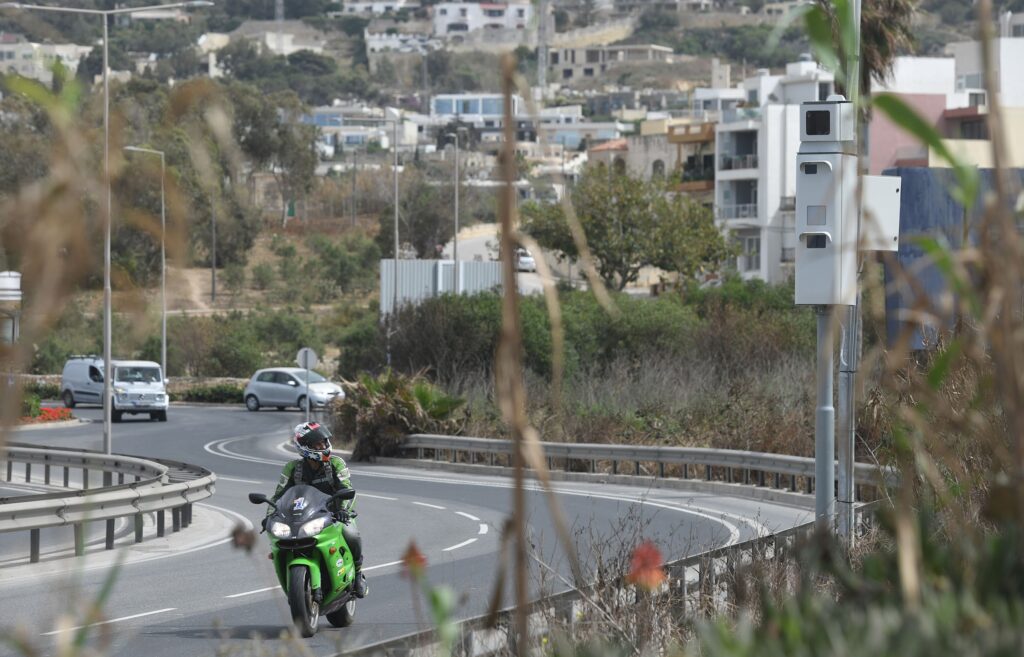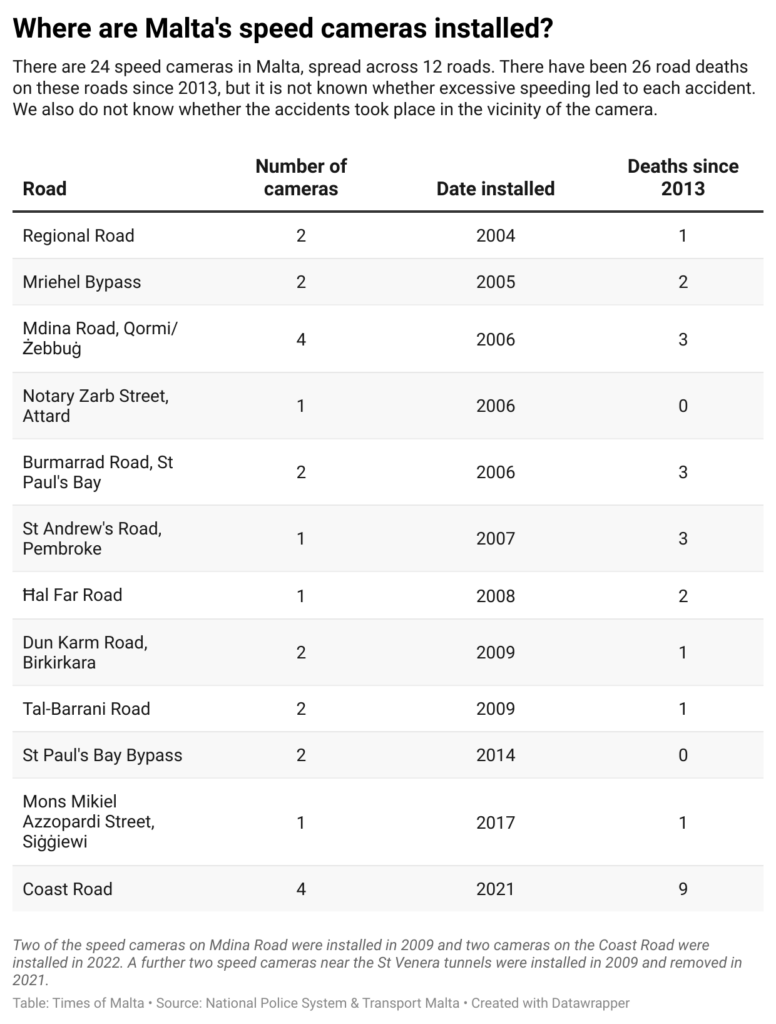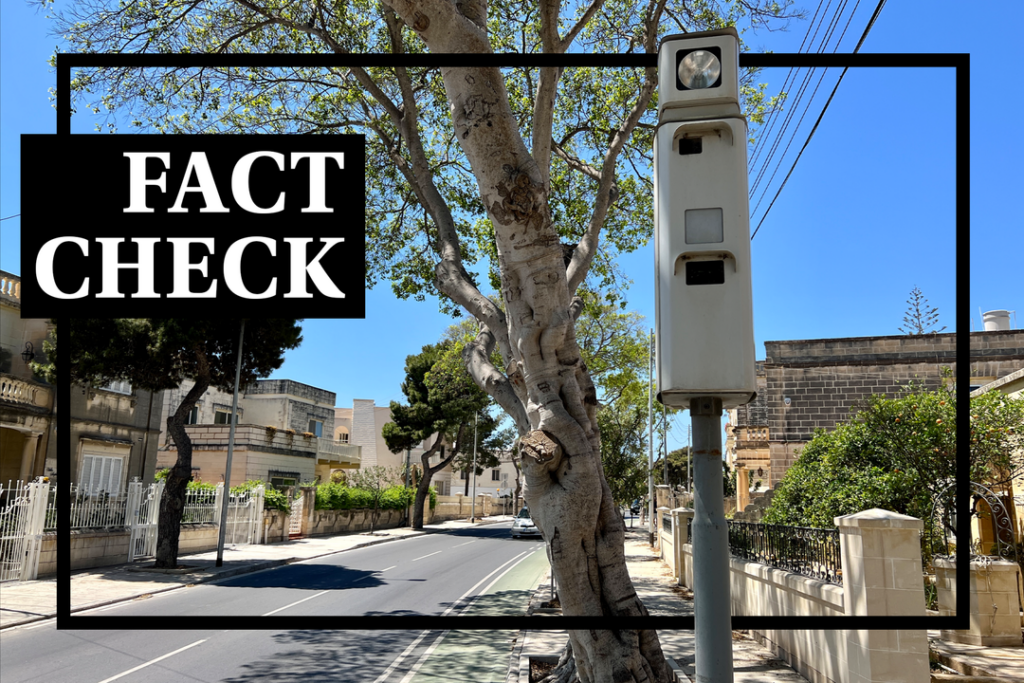The death of teenager Kacey Sciberras in a car crash earlier in May renewed concerns over road safety, with local councillors in the town of Attard calling for the introduction of a speed camera in the area where the accident happened.
Prime Minister Robert Abela argued that installing more speed cameras will not automatically resolve Malta’s road safety issues, saying that other measures also have a part to play in making Malta’s roads safer.
Malta’s road safety has long been under the spotlight, with 2022 being the deadliest year on record, with 26 road deaths. EU data shows that Malta records 50 deaths per million inhabitants, higher than the EU average of 46. Four people died on Malta’s roads in the past month alone.
Public debate on the issue has long been divided, with some describing speed cameras as cash cows for the government of the day, arguing that excessive speeding is not necessarily a leading cause of accidents. Meanwhile, others call for the introduction of more speed cameras and traffic calming measures as a key measure to improve road safety.
What role does speeding play in road accidents?
There is no publicly available local data about how many collisions, injuries or fatalities were caused by speeding. However, international research shows that there is a clear relationship between speeding and the frequency of accidents.
Research in Sweden and the UK shows that even just a 1km/h increase in average speed may increase accident numbers by up to 4% on urban roads. It has been estimated that a third of all traffic collisions in the UK are speed-related.
Accident data shows that speeding is not only linked to a higher number of accidents, but also to how serious the consequences of the accidents are.
Speeding was a factor in 29% of all US road fatalities in 2021 according to US data, while several studies suggest that an increase in speed drastically increases the severity of injuries suffered during a crash, particularly in the case of vulnerable road users such as pedestrians, cyclists and motorcyclists.
US data shows that excessive speed is by far the most frequent cause of fatalities caused by improper driving, more than double other causes such as dangerous overtaking, road rage, and not obeying traffic signs.
Do speed cameras reduce the number of accidents?
Again, local research is scarce, but several international studies show that this is the case.
One 2017 study analysing accident rates across over 2,500 sites in the UK where fixed-speed cameras were installed found that the number of collisions and minor injuries fell by up to 39%, while that of serious injuries and fatalities fell by up to 68% and 55% respectively.
Another review of several studies found that speed cameras reduced the number of accidents by up to 49% and the number of accidents leading to serious or fatal injuries by up to 44%.
Generally, fixed point speed cameras were found to be highly effective at reducing accidents within the immediate vicinity of the camera, with the rate of accidents decreasing drastically within the 500 metres surrounding the camera.
However, accident rates tended to rise back to expected levels within 1.5km of the camera, with researchers confirming what many suspect to be the case, namely that there may be a ‘halo’ effect where drivers slow down while approaching a speed camera and accelerate away the moment it is in their rear-view mirror.
Some research also suggests that speed cameras may be more effective on lower-speed or urban roads, with one study finding that the number of drivers caught speeding on roads with a speed limit of 80km/h is higher than that on roads of 100km/h or over.

Would average speed cameras work in Malta?
Some have advocated moving away from fixed-point speed cameras to other forms of enforcement, particularly average speed cameras which track the average speed of a vehicle between two points.
Like fixed point cameras, average speed cameras were found to be highly effective in reducing the number of collisions as well as severity of injuries and the number of fatalities when accidents do happen. Fatal or serious injuries fell by up to 46% following their introduction, according to one study.
However, whether average speed cameras can be widely used in Malta remains unclear.
Some studies suggest that in order for an average speed camera to be effective it needs to be installed on an extensive stretch of road, usually between two and five kilometres long, which does not contain any junctions, roundabouts or other obstacles.
Relatively few stretches of uninterrupted road of that length exist in Malta.
Nonetheless, research by the UK’s Royal Automobile Club Foundation found that average speed cameras are used in stretches of road as short as 390 metres (and as long as 46km) in the UK.
Does Malta have fewer speed cameras than elsewhere?
No, quite the contrary.
Figures compiled by a private international speed camera database indicate that Malta has 66.5 speed cameras per 1,000 square kilometres, the second highest rate in Europe. Malta’s rate is double that of Italy, which lies in third place with 33.8 speed cameras per 1,000km squared.
However, these figures need to be treated with caution. Aside from the number of cameras in each country not being independently verified, Malta’s dense, highly urbanised road network may be more comparable to specific cities and towns across Europe, rather than entire countries which also include large stretches of rural or uninhabited land.
Aside from fixed point speed cameras, Malta also introduced mobile speed cameras in recent years, with both police and LESA now equipped with speed guns which can detect speeding drivers across various locations.
What does local accident data show?
Police data shows that over the past ten years, there have been 26 fatalities on Maltese roads where speed cameras are installed. The deadliest of these roads was the Coast Road, where 9 people lost their lives since 2013.

However, the relationship between these incidents and the presence of speed cameras is unclear for several reasons.
Firstly, some of these deaths pre-date the installation of speed cameras and may have influenced the decision for one to be installed. Secondly, police records do not indicate whether the accident took place in the vicinity of the speed camera, or on a different stretch along the same road. Finally, it is unclear how many of these accidents were caused by excessive speeding or whether other factors were at play.
Verdict
Studies show that excessive speeding is a leading cause of road collisions, with even minimal increases in speed having drastic effects on the number of accidents and fatalities.
Although local data on the effectiveness of speed cameras is not available, several studies in Europe, North America and Asia show that they are highly effective in reducing the number of accidents as well as the severity of injuries and number of deaths.
However, speed cameras are most effective within their immediate vicinity and are less effective in preventing accidents at a distance of over a kilometre away from the camera.
Average speed cameras are also highly effective, particularly on long stretches of interrupted road, although it is unclear whether they can be widely used in Malta given the nature of Malta’s road network.
The Times of Malta fact-checking service forms part of the Mediterranean Digital Media Observatory (MedDMO) and the European Digital Media Observatory (EDMO), an independent observatory with hubs across all 27 EU member states that is funded by the EU’s Digital Europe programme. Fact-checks are based on our code of principles.
Let us know what you would like us to fact-check, understand our ratings system or see our answers to Frequently Asked Questions about the service.





